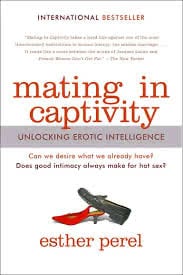Mating in Captivity

Esther Perel, 2007, 272 pages
A mantra of my post-graduate training in couples, family and sex therapy was that when a couple is struggling in the bedroom, that struggle is a mirror for what’s happening outside of the bedroom. So, if you help a couple increase intimacy and enhance communication, and you employ the sex therapy strategies appropriate to any sexual dysfunction, great sex will follow.
Sometimes, this mantra holds true. Other times, however, a couple may describe a wonderful relationship, and yet their sex life has faltered.
Esther Perel’s groundbreaking book, Mating in Captivity, writes of such couples with extraordinary insight and tremendous depth. The concepts presented and the couples detailed throughout her book ring true to what I have noticed in my own clinical work. Often, they have become so close that they have merged into one. Through this blending of their identities, they unintentionally extinguish their flame of desire. As Perel points out, desire is often connected to uncertainty, and uncertainty implies and craves space. If a couple loses the psychological space that allows them to fully exist as two separate, sexual beings, they often compromise their sexual desire for each other.
In one of many moving passages, Perel writes:
“Rather than looking at sex as an exclusive outgrowth of the emotional relationship, I’ve come to see it as a separate entity. Sexuality is more than a metaphor for the relationship – it stands on its own as a parallel narrative. The intimate story of a couple can indeed tell us a lot about their erotic life, but it can’t tell us everything. There is a complex relationship between love and desire, and it is not a cause-and-effect linear arrangement. A couple’s emotional life together and their physical life together each have their ebbs and flows, their ups and downs, but these don’t always correspond. They intersect, they influence each other, but they’re also distinct. That’s one reason why, to the chagrin of many, you can often “fix” a relationship without doing anything for the sex. Maybe intimacy only sometimes begets sexuality.”
Without appropriate psychological distance, desire may be drastically diminished even if love remains steady and strong. Perel explains:
“It is too easily assumed that problems with sex are the result of a lack of closeness. But my point is that perhaps the way we construct closeness reduces the sense of freedom and autonomy needed for sexual pleasure. When intimacy collapses into fusion, it is not a lack of closeness but too much closeness that impedes desire… When people become fused – when two become one – connection can no longer happen. There is no one to connect with. Thus separateness is a precondition for connection: this is the essential paradox of intimacy and sex.”
As a couples therapist, I find it effective to teach and emphasize the concept of psychological space. Discussing the correlation between emotional maturity and the ability to be engaged in a relationship but still exist as a truly separate self often helps clients bring enough distance into their relationship to rekindle their desire. To this end, Mating in Captivity provides a refreshing and honest conversation about the difficult question of how to keep a marriage engaged and dynamic while keeping the sex exciting and the desire strong.
For those who find that they love their partner, but their sexual desire has decreased, Mating in Captivity is essential reading. As a prequel, watch Perel’s TED talk. Especially refreshing is Perel’s willingness to dissect challenging and complicated questions about infidelity, fetishism, fantasy, psychotherapy and sexuality while resisting the urge to provide simple tidy answers. Perel understands that the conversation itself has great meaning and allows readers to decide and decode the answers for themselves.
